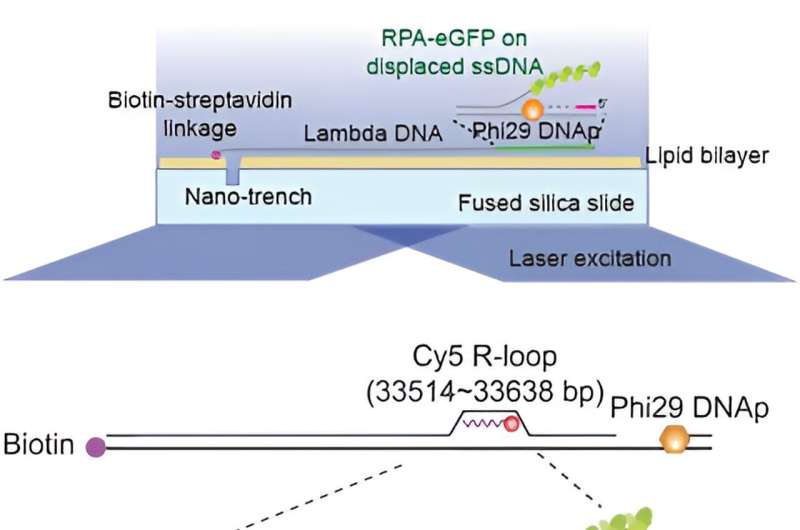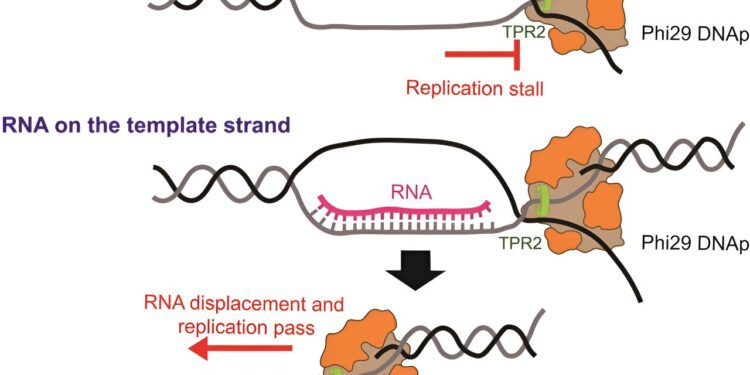Scheme for direct visualization of the collision between Phi29 DNAp and R-loops. Credit: Nucleic acid research (2023). DOI: 10.1093/nar/gkad1101
A research team led by Professor Ja Yil Lee from the Department of Biological Sciences at UNIST has achieved a breakthrough in the field of molecular biology. Their research, published in the journal Nucleic acid researchsuccessfully visualized the DNA replication process in real time using innovative “DNA curtain” technology.
This achievement represents the first-ever direct observation of DNA replication and its conflicts with R-loops and transcription proteins, shedding new light on long-standing questions in this field.
DNA replication plays an essential role in transferring genetic information to the next generation. However, it frequently encounters obstacles such as interference caused by the transcription process or collisions with R loops, which result from incomplete transcription.
These phenomena, collectively known as “DNA replication stress,” have been associated with various diseases, including cancer, neurological disorders, and aging. Therefore, gaining a comprehensive understanding of the conflicts between replication, transcription, and R-loops is of paramount importance for the development of potential disease prevention and treatment strategies.
To directly visualize the DNA replication process, the research team used DNA curtain technology, a single-molecule imaging approach. This technique facilitated the direct observation of collisions between DNA replication and transcription or R-loops. Through their experiments, the team demonstrated that even a single R-loop can prevent DNA replication and induce replication stress, with a higher degree of blocking observed when an RNA-DNA hybrid is present on the non-template strand.
The team identified that this asymmetry results from the formation of secondary structure on the non-template strand, hindering the progression of the Phi29 DNA polymerase. Furthermore, the formation of G-quadruplex structures on single-stranded DNA displaced within an R-loop amplifies the replication block. Additionally, the researchers observed collisions between DNA polymerase Phi29 and RNA transcripts synthesized by RNA polymerase T7, revealing that RNA transcripts cause more frequent blocks due to the presence of RNA T7 polymerase.

(Top) Schematic of a DNA curtain for Phi29 DNAp replication. Modified lambda DNA (λ-I3) is modified with biotin and a primer for Phi29 DNAp replication at each end. In the DNA curtain, Phi29 DNAp synthesizes DNA from the primer unwinding duplex DNA. RPA–eGFP binds to the displaced non-template strand. RPA–eGFP is fluorescence imaged by TIRFM. (Middle) Schematic of the DNA curtain test for the collision between Phi29 DNAp and an R-loop. (Bottom) Kymographs showing the dropout of Phi29 DNAp for the collision with the R-loop of RD_T. Credit: Nucleic acid research (2023). DOI: 10.1093/nar/gkad1101
“DNA replication is at the heart of life phenomena, and this study represents the world’s first real-time fluorescence imaging of DNA replication and its conflicts with transcription and R-loops,” noted Professor Lee. “This provides a direct answer to the long-standing problem in molecular biology known as “replication-transcription collision.” » He added: “In the future, we aim to apply this revolutionary technology to research on human DNA replication and transcription. ”
Subin Kim, first author of this study and a Ph.D. researcher, highlighted the importance of the findings, particularly with regard to R-loops, which are actively studied worldwide as potential causes of various diseases, including cancer and neurological disorders such as leukemia. The study is expected to make a substantial contribution to the development of treatments for R-loop-associated diseases.
More information:
Subin Kim et al, Direct visualization of R-loop replication and collision using single-molecule imaging, Nucleic acid research (2023). DOI: 10.1093/nar/gkad1101
Provided by Ulsan National Institute of Science and Technology
Quote: “DNA curtain” technology enables real-time visualization of replication for new scientific insights (December 4, 2023) retrieved December 4, 2023 from
This document is subject to copyright. Apart from fair use for private study or research purposes, no part may be reproduced without written permission. The content is provided for information only.



